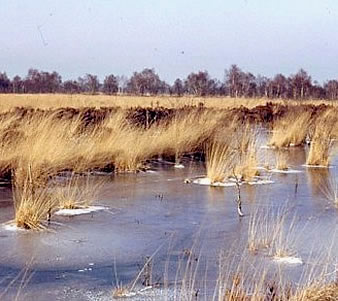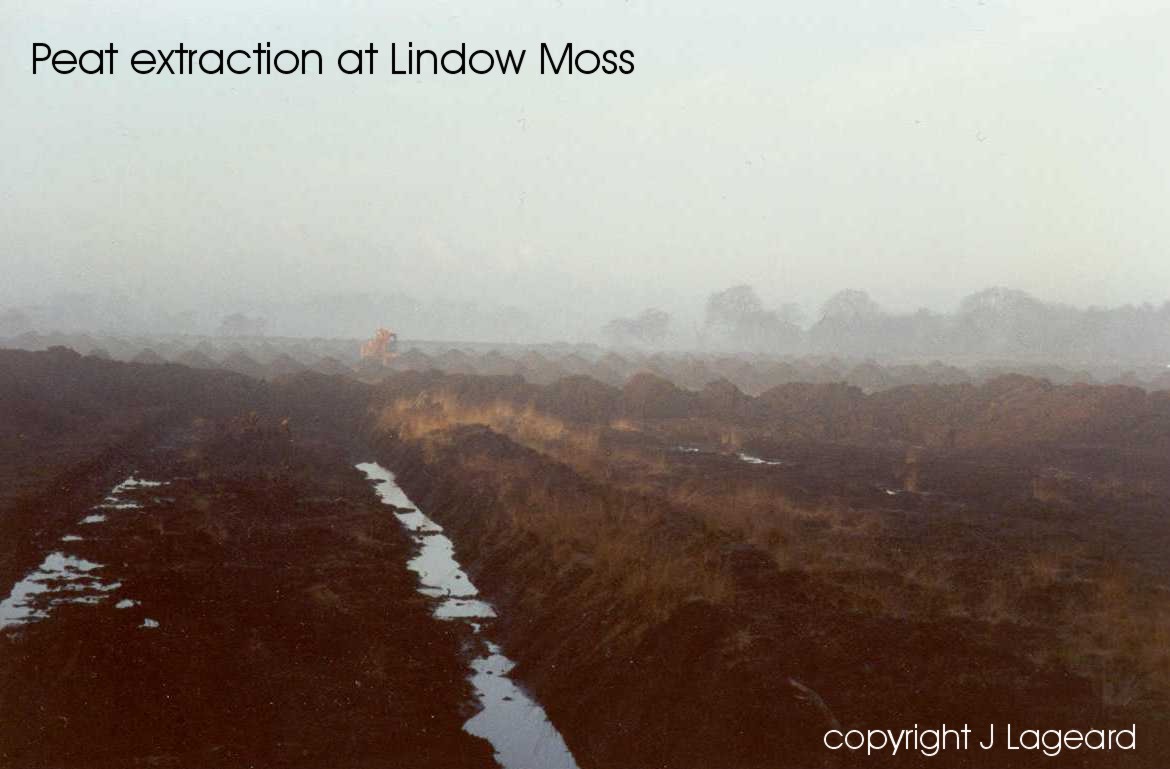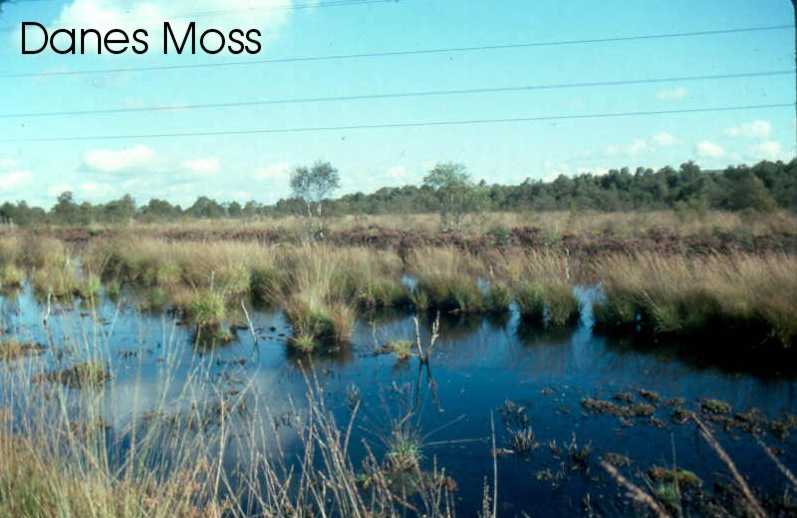LOWLAND RAISED BOG (FORMERLY PEATLANDS)
LOCAL BIODIVERSITY ACTION PLAN
 Links to associated SAPs
Links to associated SAPs
None
Current Status
Lowland raised bogs are peatland ecosystems which develop primarily in lowland areas such as the head of estuaries, along river flood plains and in topographic depressions. In such locations drainage may be impeded by a high groundwater table, or by low-permeability substrata. The resultant waterlogging provides anaerobic conditions which slow down the decomposition of plant material which in turn leads to an accumulation of peat. Continued accrual of peat elevates the bog surface above regional groundwater level to form a gently curving dome, from which the term ‘raised’ bog is derived. The thickness of the peat mantle varies considerably but can exceed 12 metres.
Lowland raised bogs may develop from a preceding phase of fen via successional processes or, if the climate is sufficiently wet, by peat formation directly onto a bare substrate, a process known as ‘paludification’. Accumulation of peat separates the bog surface from the influence of groundwater, so that it becomes irrigated exclusively by precipitation, giving rise to an ‘ombrotrophic’ bog. The raised bog surface may support a patterned surface of pools, hummocks and lawns, which provide a range of water regimes supporting different species assemblages, in particular, of Sphagnum mosses.
Lowland raised bogs also support a distinctive range of animals including a variety of breeding waders and wildfowl, and many rare and localised invertebrates.
Peat accumulation preserves a unique and irreplaceable record of plant and animal remains and some atmospheric deposits from which it is possible to assess historical patterns of vegetation and climate change and land-use.
An estimated 97% of lowland bogs in England and Wales have been damaged or destroyed. In Cheshire all areas of lowland raised bog have been disturbed to some extent, although a remnant of Holcroft Moss is thought never to have been cut. Thus conservation of remaining peatlands has become increasingly important, nationally and internationally.
Cheshire County Peatland inventories have been produced by Penny Anderson Associates (1994) and Cheshire County Council in partnership with English Nature and the former National Rivers Authority during 1994 and 1996. From these, 433 peatland sites covering 5,066ha have been identified, of which 1,392ha (27%) are lowland raised bogs still supporting semi-natural vegetation. The North West Wetland Survey also produced a wetland inventory for the county in 1997 in order to assess archaeological potential.
 Threats
Threats
-
Drainage of peat body (mainly historical)
-
Maintenance of drainage systems
-
Eutrophication
-
Peat extraction (currently active at two sites, Lindow & White Mosses).
-
Underlying mineral extraction (White Moss).
-
Modification for agriculture
-
Modification for forestry
-
Waste disposal on sites
-
Natural succession (accelerated by drainage).
-
Inappropriate / insufficient management
-
Inappropriate development
-
Fire
How are we helping to conserve Lowland Raised Bog in the Cheshire region?
-
Flaxmere Moss SSSI and Wybunbury Moss SSSI are included within the Midlands Meres and Mosses (phase 1) Ramsar site, designated on 9 May 1994.
-
Linmer Moss is included in the Midland Meres and Mosses (phase 2) Ramsar site designated on 2 February 1997.
-
Wybunbury Moss SSSI, Holcroft and Risley Mosses are submitted as candidate Special Areas for Conservation under the EC Conservation (Natural Habitats) Regulations 1994.
-
Danes Moss and Holcroft Moss are being actively managed by Cheshire Wildlife Trust. Action includes tree and shrub clearance, dam installation to restore hydrology, grazing and continued monitoring of sites. Management Plans are being prepared for these two sites.
-
3ha at Danes Moss re-wetted.
-
Wybunbury Moss is a National Nature Reserve and is actively managed by Natural England.
-
Within Delamere Forest, Forest Enterprise are felling trees from peat areas, this includes 46.7ha felled on Blakemere Moss which has been re-wetted (1997).
-
Natural England is actively re-wetting Risley Moss SSSI and LNR in partnership with Warrington Borough Council.
-
A dedicated Project Officer has been appointed to target Agri-environment scheme payments in the catchments of Meres and Mosses SSSIs.
-
A local BAP group for Peatlands was formed in June 1998.
-
Two reports prepared for English Nature (ECUS 1998a & b) were presented at the Meres and Mosses Forum (Liverpool University, 22 September 1998) and underpin the Meres and Mosses Strategy (English Nature). This Strategy is directed specifically at site owners, managers and monitoring bodies, with the aim of raising awareness of issues and highlighting solutions, especially to tackle the adverse influences arising from the catchments.
-
CCC are now looking at peat policies within the County, and are also producing an alternative 'soil improver' from composted green waste.
Objectives, Targets and Actions
OBJECTIVES |
LOCAL TARGETS |
1. Maintain the current distribution and extent of primary near-natural lowland raised peat bog.
2. Ensure that the condition of this resource is maintained where favourable or enhanced through appropriate management. |
1. Establish by 2005 appropriate hydrological and management regimes at those areas which have been damaged but still retain nature conservation interest, and aim to achieve favourable condition of these areas by 2015.
2. Identify areas for restoration or improvement of significantly altered raised bog areas, including those used for agriculture, peat workings and woodlands, and implement a programme for restoration and management by 2005. |
ACTIONS REQUIRED |
-
Where possible stop or reduce peat extraction. At Lindow Moss, to keep a close watching brief on new proposals. At White Moss, action required to persuade owner to conserve existing peat body.
-
Make information available to encourage awareness of the importance of lowland raised bogs.
-
Reduce possibilities of disturbance from surrounding areas by encouraging sympathetic management by landowners
-
Promote research into alternatives to peat and moss in horticulture through links with the Gardens and Allotments BAP.
-
Promote the pooling of information concerning raised bog management and restoration techniques.
-
Monitoring of lowland raised bogs for any further degradation and improvements.
-
Targetting of modified lowland raised bogs identified in Peatland Inventories for potential SBI designation. Reassessment of existing SBIs as Grade A under new criteria.
-
Reconvene Peatlands Action Group to cover lowland raised bog and fen habitats.
|
Progress so far
| 1997 - 2006 Action Completed |
-
Identification of peatlands that qualify for protection under national and international laws.
-
Risley Moss and Holcroft Moss have been designated as part of the Manchester Mosses cSAC
-
Cheshire County Council have signed up to the Peatland Charter
-
Cheshire's peatland resource, both current and potential, are included on the County's GIS database.
-
NVC Vegetation Survey completed for all mere and moss SSSIs.
-
Management work was carried out at Brookhouse Moss and Flaxmere Moss in 2003.
-
Meres and Mosses Forum meeting held 1 July 2003.
-
Phase 1 of the North West Wetlands Network Project, funded by English Nature, Environment Agency and North West Development Agency, to identify the socio-economic value of wetlands in the North West completed in 2004. Funding for Phases 2 and 3 now secured for 2005.
-
Danes Moss - 6 ha of degraded bog re-wetted and 6 ha of invasive scrub removed in 2004. Ongoing restoration work in 2004 at Brookhouse Moss, Wybunbury Moss, Flaxmere Moss and Holcroft Moss. Hydro-ecological assessments undertaken in 2004 of Abbots Moss, Wybunbury Moss and Flaxmere Moss.
-
Management Plan completed for Risley Moss in 2004.
|
How to find out more about Lowland Raised Bog
UK BAP for Lowland Raised Bog - www.ukbap.org.uk/UKPlans.aspx?ID=20
Contact details
| LBAP Chair |
Mandy North, Natural England
Phone: 01942 820342 |
| National Lead Partner |
Natural England |
| National Contacts |
Roger Meade, Natural England
Phone: 01733 455565
Rebecca Longfield, Faber Maunsell
Phone: 01733 391456 |
 References & Glossary
References & Glossary
Anderson, P. (1994): Cheshire Peatland Inventory Phase I, Cheshire County Council
Department of the Environment (1994): Report of the Working Group on Peatland Extraction and Related matters
Guest, J. (1996): Cheshire Peatland Inventory Phase II, Cheshire County Council
Environmental Consultancy University of Sheffield (ECUS) 1998a: Feasibility Study for the Management of two selected West Midland Wetland complexes. Case Studies: Action Plan for Pettypool, Brook Valley, Cheshire. Report for English Nature.
ECUS 1998b: Feasibility Study for the management of two selected West Midland wetland complexes. Blueprint document for English Nature.
HMSO (1995): Biodiversity: The UK Steering Group Report, Volume 1: Meeting the Rio Challenge, London
HMSO (1995): Biodiversity: The UK Steering Group Report, Volume 2: Action Plans, London
Leah, M. et al. (1997): North West Wetlands Survey 4: The Wetlands of Cheshire.
Lindsay, R. (1995): Bogs: The ecology, classification and conservation of ombrotrophic mires. Scottish Natural Heritage
Marshall, I (1996): Draft habitat biodiversity action plan: Cheshire Peatlands. Cheshire County Council Environmental Planning Service.
McCall, A (1996): Plants without peat 1996 report. Scottish Wildlife Trust for the Peatlands Campaign Consortium.


 Links to associated SAPs
Links to associated SAPs  Threats
Threats  References & Glossary
References & Glossary